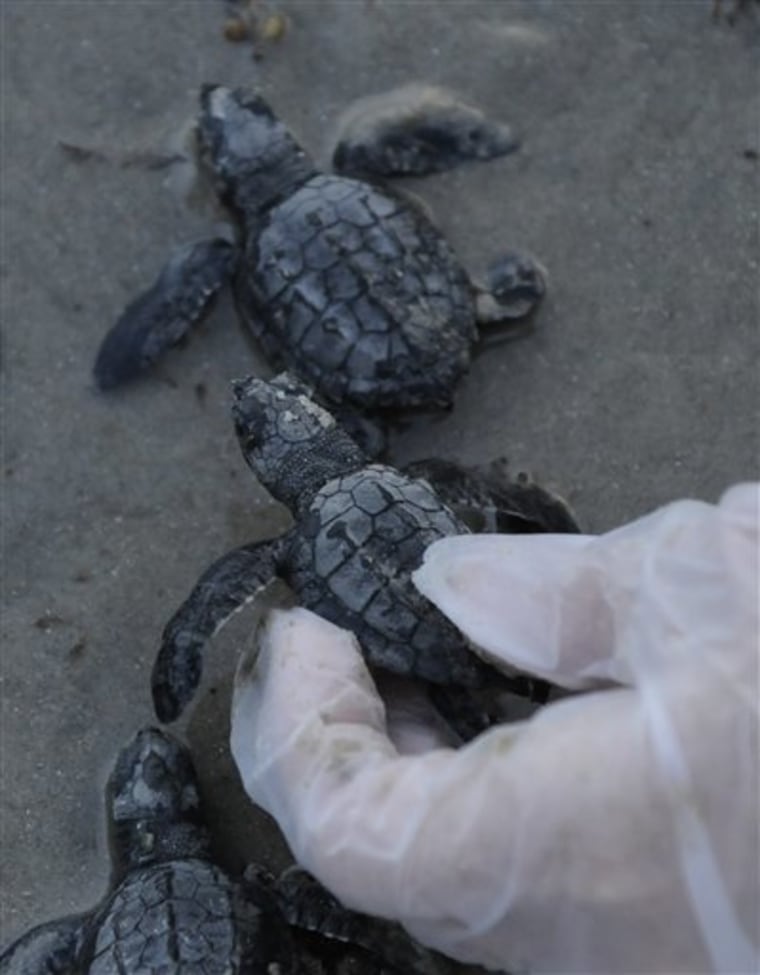Hundreds of tiny baby turtles with their dime-sized paddle-like feet dragged through the sand on Monday heading for a new home in the Gulf of Mexico despite the threat of oil some 400 miles away.
Born just days ago, these endangered Kemp's ridley sea turtles were released off the Texas coast to a perilous life fleeing predators — and now also oil from the BP spill.
Unlike a decision to move loggerhead turtles in Florida to safer waters, the U.S. Fish and Wildlife Service and the National Park Service decided in June to go ahead with the annual releases of thousands of Kemp's ridley turtle off the coasts of Texas and Mexico.
Since then, between 7,000 and 8,000 baby Kemp's have been released.
The Kemp's loggerhead cousins, who mostly nest and hatch in Florida, are being moved to that state's eastern coast to ensure they are not released directly into the oil's path. As for the Kemp's, federal biologists hope by the time the silver-dollar sized critters swim to the spill zone, BP will have cleaned up the toxic gook.
The biologists believe that baby turtles released in areas not directly impacted by the oil would suffer greater harm if they were held in captivity until the slick is cleaned. The decision to release the Kemp's has stirred debate, though, especially among those who fear the turtles' recovery will suffer a major setback due to the spill.
Donna Shaver, the National Park Service's resident turtle expert, is doing everything to make the releases a success though she is worried about the hatchlings — and their mothers, many of whom she is tracking and are now foraging in Louisiana waters.
"There are concerns about potential impacts to the turtles form that captive rearing, impacts on their behavior after they're released," Shaver said.
Kemp's ridley turtles have been on the endangered list since 1973, and the U.S. and Mexico have worked together since then to try to rejuvenate the species. Charles W. Caillouet Jr., a retired fishery biologist with the National Oceanic and Atmospheric Administration in Galveston, oversaw a "head start" program from 1978 to 1993 that included raising Kemp's ridley turtles until they were up to 11 months old. He believes the program was successful at increasing the turtles' numbers, especially on Texas beaches.
"Some survived, adapted well to conditions even though they'd been in captivity and some survived to mature and some of them reproduced," Caillouet said.
Still, he is not certain that holding a few thousand in captivity until the oil is cleaned would help the turtles.
"We will know next year if there was a substantial impact on the population," Caillouet said.
Of the 638 turtles that have been found dead since the oil spill, federal statistics show that about 524 of them — or 82 percent — are Kemp's ridleys.
This means there are many of these turtles in the Gulf, Caillouet said.
Shaver's journey to save the species began in 1980. Along with some 150 volunteers and other staff, she patrols Padre Island's beaches, collecting the nests, incubating them and waiting for them to hatch.
"We work extremely hard to try to find the nests, to try to tend to the eggs to get as good a hatching success as possible," Shaver said.
Once they hatch, Shaver spends nights monitoring the babies.
For weeks in the summer, she catches catnaps on a bed in her office, waking every hour to the sound of a timer around her neck so she can check on the turtles and listen for scratching — a sign they have entered the critical "frenzy" stage that signals they need to be immediately released into the water.
Beginning Sunday evening and throughout Monday night, groups of hundreds of turtles scratched for Shaver. Some 1,000 Kemp's were let loose throughout the night — 165 of them early Monday.
Volunteers first raked the beaches of the cumbersome, thick seaweed covering the sand, making sure the turtles don't expend extra energy plowing through the sticky threads. Others held nets overhead making sure the predatory seagulls couldn't scoop down and make off with a baby. Still more stood in the water with sticks and orange streamers, scaring the gulls away from the water.
"We don't just want to be feeding the birds and fish," Shaver said, explaining that the oil is now an added worry for her when she frees the babies she spends so much time nurturing.
